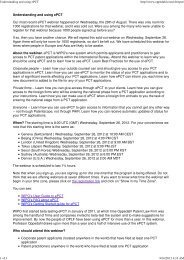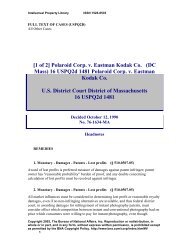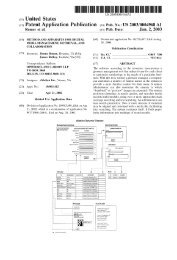48804 Federal Register / Vol. 77, No. 157 / Tuesday, August 14, 2012 / Rules and Regulationssro<strong>be</strong>rts on DSK5SPTVN1PROD with RULESrequire an assignment with such oath ordeclaration statements to <strong>be</strong> included inthe application file and did not envisionthat the statement would <strong>be</strong> ‘‘examined’’by a patent examiner. These commentsstated that 35 U.S.C. 115(e) permits theassignment to simply <strong>be</strong> recorded in theassignment records without submittinga copy in the application file.Response: 35 U.S.C. 115(e) providesfor making the statements requiredunder 35 U.S.C. 115(b) and (c) in an‘‘assignment of record,’’ and 35 U.S.C.115(f) provides that a notice ofallowance under 35 U.S.C. 151 may <strong>be</strong>provided to an applicant only if theapplicant has filed each required oath ordeclaration under 35 U.S.C. 115(a), orhas filed a substitute statement under 35U.S.C. 115(d), or recorded anassignment meeting the requirements of35 U.S.C. 115(e). 35 U.S.C. 115(e) and (f)(emphasis added). Thus, the recordingrequirement of § 1.63(e)(1)(ii) is requiredby 35 U.S.C. 115, which envisions thatthe assignment containing thestatements required of an oath ordeclaration <strong>be</strong> ‘‘recorded.’’ 35 U.S.C.111(a)(2)(C) also requires that anapplication contain an oath ordeclaration. If an applicant files inpaper an assignment-statement forrecordation together with a patentapplication, the Office will scan a copyof the assignment into the Office IFW ofthe application and forward thesubmission to Assignment RecordationBranch provided that there is aconspicuous indication of an intent toutilize the assignment as the requiredoath or declaration under § 1.63.Comment 30: One comment statedthat proposed § 1.63(a) should <strong>be</strong>amended to clarify that an assignmentthat includes the statements required by35 U.S.C. 115(b) and (c) may <strong>be</strong> filed ‘‘inlieu of filing such statementsseparately’’ pursuant to 35 U.S.C.115(e).Response: Section 1.63(e)(1)implements that portion of 35 U.S.C.115(e) relating to the ‘‘in lieu of’’language by its recitation that anassignment may also serve as the oathor declaration.Comment 31: With respect to thecombined assignment and oath ordeclaration document, one commentquestioned the result if one portion isdetermined to <strong>be</strong> void or voidable. Thecomment specifically questionedwhether the declaration portion would<strong>be</strong> void or invalid where the assignmentportion is found to <strong>be</strong> void or invalid.The comment stated that the Officeshould clearly indicate that the legality(or invalidity) of one part will notimpact the other part.Response: Where there is an error inthe oath or declaration portion, such asin bibliographic information, the rest ofthe oath or declaration is still effectiveand only that error need <strong>be</strong> corrected.See § 1.67(a). In other instances, such asa failure to provide a statutorilyrequired averment, the oath ordeclaration must <strong>be</strong> resubmitted. Wherethe assignment portion of a combinedassignment and oath or declarationdocument is found to <strong>be</strong> invalid, thecombined assignment and oath ordeclaration document would remaineffective for the declaration portionprovided that the assignment containsthe statements required of an oath ordeclaration.2. Recordation of AssignmentsComment 32: One comment opposedthe proposed addition to a recordationcover sheet of a check-box indicatingthat the assignment is to <strong>be</strong> used in anapplication to comply with § 1.63. Thecomment asserted that the person filingthe assignment is likely not a registeredpractitioner and should not have theburden of arriving at a legal conclusionas to whether the document is to serveas a declaration. The comment furtherasserted that the application andassignment are frequently separatelyfiled electronically by differentindividuals, and requested that the ruleshould <strong>be</strong> tailored for non-electronicfiling of the assignment containing theinventor statement. Another commentsuggested that the Office should updatethe Office’s Patent ApplicationInformation Retrieval (PAIR) system todirectly link recorded assignments tothe application as recorded assignmentsare now accessible only by physicallytraveling to the Office, at substantialburden and cost on the requester.Response: Section 3.31 requires thatwhere an applicant has included thestatements required by 35 U.S.C. 115(b)and (c) in an assignment, the applicantindicate as much to the Office via acheck-box on the assignmentrecordation cover sheet. Thus, the Officewill know both to record the assignmentin the assignment database and to placea copy of the assignment in its relatedapplication file, so that applicants willnot <strong>be</strong> required to submit an oath ordeclaration in the application.There are three ways to submit anassignment-statement document: (1) Inpaper (including facsimiletransmission); (2) through the ElectronicPatent Assignment System (EPAS); and(3) via EFS-Web. For paper submissions,the Office frequently receives in thesame envelope a patent application, anassignment to <strong>be</strong> recorded in connectionwith that application, the AssignmentVerDate Mar2010 17:28 Aug 13, 2012 Jkt 226001 PO 00000 Frm 00030 Fmt 4701 Sfmt 4700 E:\FR\FM\14AUR6.SGM 14AUR6Recordation Cover Sheet (PTO–1595)and the recordation fee. In suchcircumstances, the Office would simplyforward the assignment document andPTO–1595 to the AssignmentRecordation Branch for recording. Asdiscussed previously, if an applicantindicates that an assignment submittedfor recording also contains statementsrequired of an oath or declaration, theOffice will scan a copy of theassignment into the Office IFW of theapplication and forward the submissionto Assignment Recordation Branch.The Office notes the concern with theability of a person submitting theassignment-statement document forrecordation <strong>be</strong>ing able to make a legalconclusion as to the ability of anassignment to serve as a combinationassignment and oath or declarationdocument and so indicate on therecordation cover sheet. The failure tocheck the box to identify the submissionas a combination assignment and oathor declaration document, however,would not prevent the applicant fromsubmitting a copy of the assignmentstatementin the application to serve asthe oath or declaration. Moreimportantly, it is not necessary for aperson to make a legal conclusion as tothe ability of an assignment to serve asa combination assignment and oath ordeclaration document and so indicateon the recordation cover sheet. Theperson would only need to know thepurpose for submission of theassignment.E. Power of AttorneyComment 33: One comment suggestedthat in regard to an application filed byan assignee-applicant, the Office shouldpermit only a power of attorney fromthe assignee-applicant and not from theinventors. One comment suggested thatthe reference in § 1.33(f) to § 3.71 (aswell as § 1.31) is unnecessary in that anassignee may easily apply for a patentand thus <strong>be</strong> the applicant referred to in§ 1.31.Response: Section 1.33(b)(3) providesthat a power of attorney can <strong>be</strong> signedby the applicant. Section 1.42(b)provides that if a person is applying fora patent as provided in § 1.46, theperson applying for a patent under§ 1.46 (and not the inventor) is theapplicant. Accordingly, an assignee orobligated assignee who has filed anapplication may supply an effectivepower of attorney without the need toestablish the right to take action under§ 3.71. For example, an assignee whofiles an application can appoint a powerof attorney, provided that the partygranting the power is the same partywho filed the application. Persons who
Federal Register / Vol. 77, No. 157 / Tuesday, August 14, 2012 / Rules and Regulations48805sro<strong>be</strong>rts on DSK5SPTVN1PROD with RULESotherwise show sufficient proprietaryinterest in the matter may supply apower of attorney along with a petitionunder § 1.46(b)(2), which power would<strong>be</strong> effective once the petition is granted.If an assignee, obligated assignee, orperson who otherwise show sufficientproprietary interest in the matter isapplying for a patent as provided in§ 1.46, the inventor is not the applicantand the Office would not accept a powerof attorney from the inventor.Comment 34: One comment suggestedthat where the original declarationprovides a power of attorney by theinventors, the power of attorney shouldautomatically ‘‘transfer’’ as <strong>be</strong>ing apower of attorney by the assignee wherethe inventors have or are obligated toassign their portion to the assignee. Thecomment also stated that the power ofattorney should continue in anapplication when ownership istransferred. Where a ‘‘new’’ assignee/applicant does not wish the originalattorney to have power of attorney, the‘‘new’’ assignee/applicant should thenprepare and file the appropriaterevocation and new power of attorneyand correspondence forms.Response: Under this final rule, anassignee may file an application on itsown <strong>be</strong>half as the applicant and shouldprovide the initial power of attorney.The transfer of ownership of anapplication is external to the Office andwould not affect any existing power ofattorney in the application file. See§ 1.36(a). It is the Office’s experiencethat where ownership of an applicationis changed, the new assignee takes overthe prosecution and provides a newpower of attorney.Comment 35: Two comments statedthat, with respect to proposed § 1.32(d),if the power of attorney in the earlierapplication is from an assignee and acontinuing application is filed that addsnew inventors, a new power of attorneyshould not <strong>be</strong> required where the newlyadded inventors have also assigned, orare under an obligation to assign, to thesame assignee and the assignment isrecorded at the Office.Response: Section 1.32(d) providesthat a power of attorney will have effectin a continuing application if a copy ofthe power is supplied in the continuingapplication, unless the power ofattorney was granted by the inventorsand the continuing application namesan inventor who was not named in theprior application. Therefore, if thepower of attorney in the earlierapplication is from the assignee (asdiscussed in the comment), a newpower of attorney is not required.Comment 36: One comment statedthat proposed § 1.32(d) should <strong>be</strong>broadened to include powers of attorneyfiled in provisional applications so thata power of attorney filed in aprovisional application would haveeffect in a nonprovisional applicationthat claims the <strong>be</strong>nefit of the provisionalapplication under 35 U.S.C. 119(e) ifsubmitted in the nonprovisionalapplication.Response: It is the Office’s experiencethat powers of attorney are not usuallysupplied in provisional applications,particularly as there is no prosecutionand they <strong>be</strong>come abandoned after a yearas a matter of law. Accordingly, there islittle need to provide for the carryoverof powers of attorney from a provisionalapplication to a nonprovisionalapplication.Comment 37: One comment assertedthat the power of attorney rules are‘‘form over substance’’ and should <strong>be</strong>relaxed. The Office should leave it tothe attorneys and law firms to obtain therequisite paperwork granting thempower of attorney, which is to <strong>be</strong>retained in the attorney’s/law firm’srecord and if an issue arises that raisesthe question of whether or not theattorney acted appropriately, the Officeshould request a copy of the requisitepower of attorney form and actaccordingly.Response: Filing of a power ofattorney in an application file is notmandatory in that an attorney can act ina representative capacity pursuant to§ 1.34, although there are somelimitations, such as signing a terminaldisclaimer, change of correspondenceaddress, or an express abandonmentwithout filing a continuation, MPEP§ 402. Given the significantconsequences to such actions, the Office<strong>be</strong>lieves that such actions should only<strong>be</strong> undertaken pursuant to a power ofattorney that is of record in theapplication file.Comment 38: One comment suggestedthat the Office should take the positionthat when an applicant-assigneeexecutes a power of attorney, theattorney of record automatically has theright to act on <strong>be</strong>half of the applicantassignee,including executing astatement under § 3.73(b). A contrarycomment stated that proposed§ 3.73(b)(2)(iii) should not <strong>be</strong>implemented since it gives significantlymore authority to patent practitionersthan an assignee may otherwiseexplicitly authorize. The commentstated that only individuals who areauthorized to act on <strong>be</strong>half of theassignee should <strong>be</strong> able to sign astatement under § 3.73(b).Response: The Office disagrees withthe position that the Office should nottreat a patent practitioner of record asVerDate Mar2010 17:28 Aug 13, 2012 Jkt 226001 PO 00000 Frm 00031 Fmt 4701 Sfmt 4700 E:\FR\FM\14AUR6.SGM 14AUR6<strong>be</strong>ing authorized to act on <strong>be</strong>half of theassignee. Section 3.73(d), as adopted inthis final rule, permits a patentpractitioner of record to sign a statementunder § 3.73(c) in patent matters. Aparty to a proceeding <strong>be</strong>fore the Officeis generally bound by the actions (oromissions) of his or her representative.See Huston v. Ladner, 973 F.2d 1564(Fed. Cir. 1992). There does not appearto <strong>be</strong> any reason to make an exceptionto this general rule for statements under§ 3.73(c). If a particular assignee hasappointed a practitioner via a power ofattorney document but does not wantthe practitioner to <strong>be</strong> able to sign a§ 3.73(c) statement, then such assigneecan inform the practitioner of such alimit on his or her authority. That,however, is a matter <strong>be</strong>tween theassignee and its chosen representative,and the Office is not the forum forresolving disputes <strong>be</strong>tween an applicantand his or her representative. See Ray v.Lehman, 55 F.3d 606 (Fed. Cir. 1995).Comment 39: One comment suggestedthat powers of attorney and statementsunder § 3.73(b) filed <strong>be</strong>fore Septem<strong>be</strong>r16, 2012 in patent applications,including provisional applications,should <strong>be</strong> grandfathered in andpermitted to <strong>be</strong> filed in pending andcontinuing applications.Response: The applicability datesection of the final rule identifies whichrules apply only to patent applicationsfiled on or after Septem<strong>be</strong>r 16, 2012.Section 3.73 applies only to patentapplications filed on or after Septem<strong>be</strong>r16, 2012, but it applies to any patentapplication filed on or after Septem<strong>be</strong>r16, 2012, even of that application claimsthe <strong>be</strong>nefit of a provisional ornonprovisional application filed prior toSeptem<strong>be</strong>r 16, 2012.F. PCTComment 40: One comment statedthat the PCT rules should no longerrequire a statement that the inventor isthe applicant for the U.S. only. Adifferent carve out in PCT for U.S. lawshould <strong>be</strong> used for what remains uniqueto U.S. law, such as where the inventoris under a continuous duty to discloseknown material information.Response: The rules governingapplicants for international applications(§§ 1.421, 1.422, and 1.424) have <strong>be</strong>enamended consistent with the AIA to nolonger require that an inventor <strong>be</strong> anapplicant in the United States.Comment 41: One comment statedthat it is unclear whether proposed§ 1.48(k) only applies if an executeddeclaration submitted under PCT Rule4.17(iv) has <strong>be</strong>en filed. The commentsuggested adding a second sentence toreference § 1.41(a)(4) for correction of
- Page 1:
UNIFORM CERTIFICATE OF ATTENDANCE F
- Page 4 and 5:
SPTO explains the America Invents A
- Page 6 and 7:
PTO/SB/01A (01-09)Approved for use
- Page 8 and 9:
PTO/SB/ (06-12)Approved for use thr
- Page 10 and 11:
PTO/ (06-12)Approved for use throug
- Page 12 and 13:
PTO/(06-1Approved for use through 0
- Page 14 and 15:
What will change about the oath ord
- Page 16 and 17:
Action item●●●If you have not
- Page 18 and 19:
But 37 CFR § 1.63 says:A person ma
- Page 20 and 21:
●●●Combined assignment anddec
- Page 22 and 23:
●●●●●●Consequences of i
- Page 24 and 25:
How to file the ADSs●●If you pr
- Page 26 and 27:
Supplemental ADSAny ADS filed after
- Page 28 and 29:
Provisionals●●●Rules are a bi
- Page 30 and 31: Are all assignees applicants?●●
- Page 32 and 33: Substitute Statement●●●This f
- Page 34 and 35: ●●●Docket consequences of the
- Page 36 and 37: New Rule-46 practice67●●●Rule
- Page 38 and 39: Consequences of AIA for PCT filers
- Page 40 and 41: If you are entrusted the US nationa
- Page 42 and 43: ●●●Choosing between a “bypa
- Page 44 and 45: ●●●Getting your name and addr
- Page 46 and 47: Exercises relating to September 16,
- Page 48 and 49: Important AIA webinar September 6
- Page 50 and 51: Exercises relating to September 16,
- Page 52 and 53: 48776 Federal Register / Vol. 77, N
- Page 54 and 55: sroberts on DSK5SPTVN1PROD with RUL
- Page 56 and 57: sroberts on DSK5SPTVN1PROD with RUL
- Page 58 and 59: sroberts on DSK5SPTVN1PROD with RUL
- Page 60 and 61: sroberts on DSK5SPTVN1PROD with RUL
- Page 62 and 63: sroberts on DSK5SPTVN1PROD with RUL
- Page 64 and 65: sroberts on DSK5SPTVN1PROD with RUL
- Page 66 and 67: sroberts on DSK5SPTVN1PROD with RUL
- Page 68 and 69: sroberts on DSK5SPTVN1PROD with RUL
- Page 70 and 71: sroberts on DSK5SPTVN1PROD with RUL
- Page 72 and 73: sroberts on DSK5SPTVN1PROD with RUL
- Page 74 and 75: 48798 Federal Register / Vol. 77, N
- Page 76 and 77: 48800 Federal Register / Vol. 77, N
- Page 78 and 79: 48802 Federal Register / Vol. 77, N
- Page 82 and 83: 48806 Federal Register / Vol. 77, N
- Page 84 and 85: 48808 Federal Register / Vol. 77, N
- Page 86 and 87: 48810 Federal Register / Vol. 77, N
- Page 88 and 89: 48812 Federal Register / Vol. 77, N
- Page 90 and 91: 48814 Federal Register / Vol. 77, N
- Page 92 and 93: 48816 Federal Register / Vol. 77, N
- Page 94 and 95: sroberts on DSK5SPTVN1PROD with RUL
- Page 96 and 97: sroberts on DSK5SPTVN1PROD with RUL
- Page 98 and 99: 48822 Federal Register / Vol. 77, N
- Page 100 and 101: sroberts on DSK5SPTVN1PROD with RUL
- Page 102: 48826 Federal Register / Vol. 77, N





